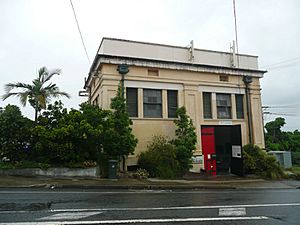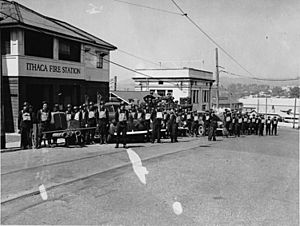Paddington Tramways Substation facts for kids
Quick facts for kids Paddington Tramways Substation |
|
|---|---|

Paddington Tramways Substation, 2009
|
|
| Location | 150 Enoggera Terrace, Paddington, City of Brisbane, Queensland, Australia |
| Design period | 1919 - 1930s (interwar period) |
| Built | 1929 - 1930 |
| Architect | Roy Rusden Ogg |
| Architectural style(s) | Classicism |
| Official name: The Substation, Paddington Tramways Substation | |
| Type | state heritage (built, landscape) |
| Designated | 22 March 1993 |
| Reference no. | 601198 |
| Significant period | 1929-1969 (historical) 1929 - ongoing (social) |
| Significant components | turbine house, views to, embankment - road, crane / gantry, substation - tramway, furniture/fittings |
| Lua error in Module:Location_map at line 420: attempt to index field 'wikibase' (a nil value). | |
The Paddington Tramways Substation is a special old building in Paddington, Brisbane, Australia. It used to be an electrical substation, which helped power the city's trams.
This historic building was designed by Roy Rusden Ogg. It was built between 1929 and 1930. Today, it is listed on the Queensland Heritage Register because of its importance. It was added to the register on March 22, 1993.
Contents
A Look Back at Brisbane's Trams
The Paddington Tramways Substation was built when Brisbane's tram system was growing. The Brisbane City Council took over the tram system in 1925. They wanted to make it bigger and better.
The first electric trams in Brisbane started running in 1897. A private company, the Brisbane Tramways Company, started them. Over time, tram lines were added to many suburbs. This included areas like Red Hill and Paddington.
The tram lines helped these areas grow. More people moved to the western suburbs because it was easier to travel.
Powering the Trams
In 1926, the Greater Brisbane Council decided to build a big power station. This was the Brisbane Powerhouse at New Farm. It opened in 1928.
The New Farm Powerhouse sent 11,000 volts of electricity to many smaller substations. These substations were built across the city. The Paddington substation was the seventh one built.
Its job was to help the Petrie Terrace substation. Together, they made sure there was enough power for all the trams in the western suburbs.
Who Designed the Substation?
Roy Rusden Ogg was the main architect for the tramways. He worked from 1926 until the late 1930s. He designed at least ten of these substations in Brisbane.
He also designed parts of the New Farm Powerhouse. The Paddington substation was special because it was the first of his designs to have a flat roof and a smooth outer finish. It was built using bricks and steel from an older power station.
How the Substation Worked
The Paddington substation was very advanced for its time. It worked automatically. It had a large transformer and a rotary converter.
Electricity came from the New Farm Power Station through underground cables. It was 11,000 volts of AC (alternating current) power.
The transformer lowered this power. Then, the rotary converter changed it to 600 volts of DC (direct current) power. This was the right kind of power for the tram network.
The substation also had an overhead crane. This crane helped move heavy equipment inside the building.
Its Working Life
The Paddington substation started working on August 11, 1930. It kept powering trams until the late 1960s.
Brisbane's trams were slowly stopped in those years. In 1969, the Paddington tram line closed. The substation's electrical equipment was taken out.
After that, the building was used as a storage place. In 1985, an art group called Hands On Art started using the building. They were still there in 2014, even holding markets.
What it Looks Like Today
The former tramway substation is a strong building made of brick with a smooth, rendered finish. It has a flat concrete roof hidden behind a wall called a parapet.
It stands out at a busy intersection in Paddington. The building looks balanced and classic in its design. It has tall, flat columns on its corners.
The building has a heavy top edge called a cornice. There are also special rough-textured panels. The bottom part looks like large stone blocks.
Inside the Building
The substation has large windows with patterned glass. There are also metal vents for air. The main doors on the north side are made of timber and are painted in bright colors.
Inside, the floors are concrete, and the walls are painted brick. Steel beams support the roof. Some windows have pink glass inserts.
You can still see where the old equipment used to be. There are floor channels where power cables ran. An upper level platform is where the rotary converter once sat.
An overhead crane is still inside the building. This crane was used to lift heavy machinery. Some parts of the original electrical system can still be seen.
Outside, there is a stone wall. This wall was part of the gardens that were once on the site.
Why it's Important
The Paddington Tramways Substation is a very important historical site. It was added to the Queensland Heritage Register in 1993.
A Piece of History
This building shows us how Brisbane's tram system grew in the early 1900s. It also shows how the city's electricity supply developed. It's a key part of Queensland's history.
Unique Design and Features
The substation is special because it still shows how the electrical system worked. It's a rare example of an old tramway substation that used a rotary converter.
It also shows how a small industrial building can be designed to look good in a city. The building was designed by important people like architect RR Ogg.
Valued by the Community
The substation is a well-known building in Brisbane. People in the community value its look and its history.
It's part of a group of important historical sites on Cook's Hill. These include the old Ithaca Fire Station and the Ithaca War Memorial. It has strong connections to the Paddington community.


